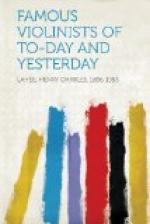Beethoven wrote for Rode, after hearing him play in Vienna, the famous violin Romance in F, Op. 50, one of the highest possible testimonials to Rode’s ability as a violinist. It is known, however, that he was obliged to seek assistance in scoring his own compositions, and therefore lacked an important part of a musical education.
The most celebrated pupil of Baillot was Francois Antoine Habeneck, the son of a musician in a French regimental band. During his early youth Habeneck was taught by his father, and at the age of ten played concertos in public. He visited many places with his father’s regiment, which was finally stationed at Brest. At the age of twenty he went to Paris and entered the Conservatoire, where in 1804 he was awarded first prize for violin playing, and became a sub-professor.
The Empress Josephine, on hearing him play, was so pleased that she granted him a pension of twelve hundred francs. He became one of the first violins at the Opera, but his special forte was as leader of orchestras, and he held that post at the Conservatoire, on account of his efficiency, until 1815, when the advent of the allied armies caused it to be closed.
Habeneck was instrumental in bringing forward the great orchestral works of Beethoven. He became director of the Grand Opera, and inspector-general of the Conservatoire.
Habeneck is said to have been greatly addicted to taking snuff, and this habit led to an amusing episode with Berlioz, which the latter regarded in a very unfriendly light. At a public performance of the Requiem of Berlioz, the composer had arranged with Habeneck to conduct the music, Berlioz taking his seat close behind the conductor. The work was commenced, and had been proceeded with some little time, when Habeneck (presumably taking advantage of what seemed to him a favourable moment) placed his baton on the desk, took out his snuff-box, and proceeded to take a pinch. Berlioz, aware of the breakers ahead, rushed to the helm and saved the wreck of his composition by beating time with his arm. Habeneck, when the danger was passed, said, “What a cold perspiration I was in! Without you we should assuredly have been lost.” “Yes,” said the composer, “I know it well,” accompanying his words with an expression of countenance betokening suspicion of Habeneck’s honesty of purpose. The violinist little dreamed that this gratification of his weakness for snuff-taking would be regarded in the pages of Berlioz’s Memoirs as having been indulged in from base motives.
Habeneck died in 1849. He published only a few of his compositions.
One of the most eminent violinists of the French school, who flourished during the early part of the nineteenth century, was Charles Philippe Lafont. Besides brilliant technical capabilities he had a sympathetic tone and a most elegant style, and these qualities gave him a very high position in the ranks of performers.




